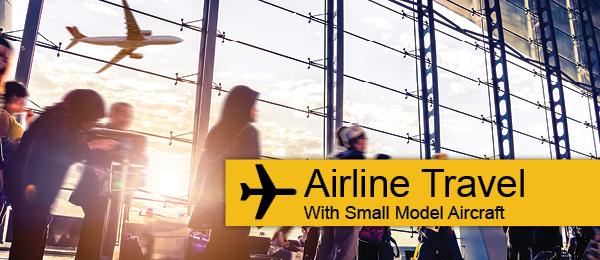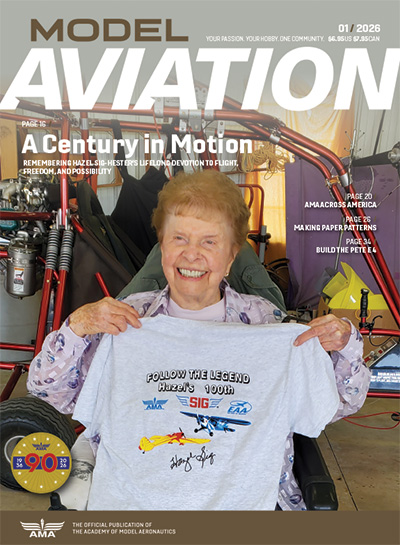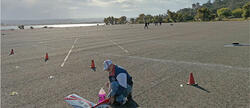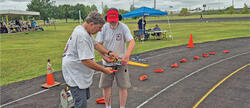AN EASY WAY TO CARRY MORE AIRCRAFT
By Ryan Bollig | rcbollig@gmail.com | Photos courtesy of the author
As seen in the June 2025 issue of Model Aviation.
I am a big micro-RC enthusiast. Foamies are inexpensive, tons of fun to fly, and easy to store. If you like to build, there are 100 years of rubber-power designs that can be converted, along with many newer, dedicated balsa kits.
Their compact size and low cost make it easy to acquire a substantial collection. If you are flying at organized indoor events, it’s natural to want to bring several models, but transporting them can be a hassle. Hauling them all in their boxes takes a lot of space and trips, but being outside of their boxes subjects the delicate models to damage unless they are carefully handled.
My friend, Dave Rush, picked up a discarded umbrella stroller and had the thought that it would make a nice cart for micro aircraft. He built a frame from PVC pipe and fittings that were taped to the stroller and found a cardboard bin that fit in the original seat area for a transmitter, batteries, etc.
Dave donated it as a raffle prize at one of our club’s indoor events and I ended up with it. I tried it out at the next indoor session and liked it. It worked fine, but with my background in product development, I could see several areas where its usability could be enhanced.


Design
The first area I wanted to address was breaking the cart down for storage when it’s not needed. The original design had a rigid frame taped to the stroller, so it was not possible to fold up the stroller without removing the tape. The PVC frame still took up quite a bit of space when it was removed.
I designed 3D-printed fittings that attach the frame to the stroller by snapping over the tubing. The rigid frame also didn’t allow for adjustment of the model support arms, which limited the airplanes that could be carried, so I also designed 3D-printed fittings that clamp on with a thumbscrew, allowing the model supports to be adjusted in use or folded flat for storage. With those changes in place, I tried it out again. It worked well but still had one flaw for my intended use.
The cart is too tall for my car when it’s upright, so I have to remove the bin and lay the cart on its back for transport. Depending on which models I had on the cart, some of the tails still stuck up a bit too high for my car, so another tweak was in order. I changed the diagonal brace design to allow the whole frame to tilt back for transport. Now I have a cart that stores compactly and allows me to carry seven models, a transmitter, and batteries in a single trip—highly desirable when flying on January mornings in Wisconsin!



Adaptability
The design presented here is built around a common Cosco umbrella stroller that can be found at your local Walmart for approximately $15, and some dimensions will be specific to that stroller. Other similar strollers should work fine for this cart, but some of the PVC lengths will need to be tailored to your application. I tried to indicate those on the drawings with an asterisk.
If you use a stroller with tubing that is a different size from the Cosco stroller, the snap fittings might not work, so I have included Solidworks and STEP CAD files with the 3D-print package. Use your choice of 3D CAD to make any necessary adjustments.
Construction
There are many 3D-printed parts, so start printing first. Polyethylene terephthalate glycol (PETG), polylactic acid+ (PLA+), acrylonitrile butadiene styrene (ABS), or acrylonitrile styrene acrylate (ASA) are ideal. Regular PLA is probably okay unless you plan to use the cart in hot weather.
Remove the fabric seat and safety belt from the stroller by taking out eight Phillips head screws. Remove the plastic footrest by drilling out the rivets. Press the M3 screw heads into the printed knobs with an arbor press, vice, or by carefully tapping with a hammer. Glue the nuts into the fittings with epoxy or clear Gorilla Glue adhesive.
Cut the PVC pipes to length and dry-fit them according to the drawing, adjusting the lengths if needed. Given the number of pieces to be cut, I found it quicker to use a Harbor Freight PVC pipe cutter than a saw. Test-mount the frame to the stroller to confirm that everything fits and works correctly. Glue the nonadjustable fittings into place with epoxy or clear Gorilla Glue.
After reassembling the frame, cut lengths of pipe insulation to cover the model arms. Tie an elastic cord around each bottom model arm and tie a loop in the free end to hook on to the anchor arms at the top of the frame. These will keep your models from moving around.
To keep the frame from sliding down onto the stroller wheels, add a wrap of tape or a small screw below the lower frame fittings. I used screws that fit into the footrest rivet holes.
Bin
If you can, find a cardboard box that fits in the seat area and is big enough for your radio and batteries. You don’t really need anything fancier. Since I wanted to maximize space and durability, I prototyped a custom-shaped bin from cardboard and duct tape then transferred the design to corrugated polypropylene. I also added handle slots for convenience. I have included the flat pattern for my bin with the 3D-print file package.
Storage
Because I only use this cart for our indoor flying season, I put much thought into making it break down easily. Remove the bin, unsnap the PVC frame, and fold up the stroller. Loosen the thumbscrews and fold all of the model arms flat with the rest of the frame. That’s it. Enjoy!

Materials needed
- Cosco Kids Comfort Height Umbrella Stroller (or similar)
- 16 feet of 1/2-inch PVC pipe
- 2 × 1/2-inch PVC elbows
- Set of 3D-printed fittings
- Six feet of elastic cord
Bin material
- Foam pipe insulation
- M3 × 30mm socket head screws (20)
- M3 hex nuts (20)
SOURCES:
Cosco Kids Comfort Height Umbrella Stroller
Walmart
3D print files
Thingiverse










Comments
Add new comment